How To Repair Snags In Knits
Imagine the wonder of elementary balls of yarn transformed, run up by run up, into beautiful, perfectly fitted sweaters or treasured one-of-a-kind gifts. Feel the satisfaction of finishing the final stitch and knowing that yous've fabricated your own creation, something that is uniquely yours.
Join the thousands of women and men -- teenagers, children, immature mothers, seniors, celebrities -- who are discovering a passion for knitting. All it takes to become started is a ball of yarn, a pair of knitting needles, and this helpful article, where y'all'll detect tips on purchasing yarn and needles, instructions for basic knitting stitch patterns, and and then much more than.
With a trivial practice, you'll soon exist knitting luxurious throws, adorable children's clothing, and fabled accessories. No doubt you'll be planning your next projection before the first is even finished!
Get downwards to the knitty gritty with assist from the following pages:
Knitting Needles
Learn nearly the wide variety of knitting needles available and how to choose the right set for your side by side project.
How to Select Knitting Yarn
Before choosing knitting yarn, check out the tips on this page to ensure you find the right weight and fiber of yarn.
How to Cast On Stitches
Find a knitting bandage-on method that suits y'all and your project in this informative department.
Learning the Knit Stitch
Master the technique of creating a perfect knit run up every fourth dimension with help from the steps and illustrations on this page.
Learning the Purl Stitch
Find out all about purling -- the other essential stitch for knitting patterns -- in this helpful section.
How to Bind Off Stitches
Begin the finishing process for your knitting project by learning how to bind off stitches on this page.
Knitting Stitch Patterns
From stockinette to garter, the stitches detailed in this section are spring to plow up in well-nigh of your knitting projects.
Agreement Knitting Instructions
Larn how to decode the instructions for knitting patterns in this helpful section.
Knitting Abbreviations
Find a long list of the nearly common knitting abbreviations and their meanings on this page.
Allow's get started by learning the ins and outs of knitting needles on the next page.
Not what you're looking for? Effort these helpful articles:
- Knitting Instructions
- Free Infant Knitting Patterns
- Free Clothing Knitting Patterns
- Costless Knitting Patterns for the Home
- Gratis Accessory Knitting Patterns
- Free and Easy Knitting Patterns
- Free Knitting Patterns
Knitting Needles
Knitting needles are available in a wide multifariousness of materials: aluminum, plastic, and other fabricated substances, along with natural woods. You lot can make your own needles out of dowels sharpened on 1 stop. Or y'all can purchase rare antique, sterling silver, or gold-plated needles, or even needles with the ends adorned with precious gems. Whichever you cull, just know they all knit the same, and all tin can become lost in the cushions of the burrow.
Novice knitters may prefer to apply needles of bamboo or forest considering the stitches are less likely to slide off. These materials help grip the stitches. With experience, yous'll detect a type or brand of knitting needle that becomes your favorite. To begin, it's a good idea to buy an inexpensive pair that appeals to you and offset from there.
Needles come up in a range of sizes, from a very tiny size 0 (you lot don't desire to showtime with these!) all the style up to size fifty (y'all'll only employ these in rare instances for specialty projects). Knitting patterns include a suggested needle size. You won't know the bodily size you need to work the design until afterward y'all make your judge swatch.
There are three styles of knitting needles: straight (single-point), circular, and double-betoken needles. The nearly common manner is straight, single-bespeak. These needles are sold in pairs and are bachelor in both 10- and 14-inch lengths. They accept a knob on the finish opposite the bespeak to preclude stitches from slipping off. The needle size is sometimes stamped on the knob or on the needle shank. Straight needles are all-time suited to working back and forth in rows to make a apartment slice of knitting.
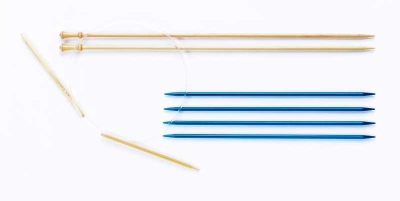
Clockwise from left:
circular needles; directly, unmarried-point needles; double-pointed needles.
To avoid sewing seams, you tin can work in rounds using circular needles. Circular needles consist of two curt needles continued by a thin, plastic cablevision. When choosing circular needles, look at the place where the cable connects to the needle. It should be smoothen then stitches glide easily from cable to needle. Round needles are available in most ordinary sizes, with cable lengths of sixteen, xx, 24, 29, and 36 inches. Use a length that comfortably holds the number of stitches you lot are using. Circular needles are used for seamless, knit-in-the-circular items, but they can be used to knit flat pieces equally well.
The third type is double-pointed needles. These short needles have an identical betoken on each terminate, and either end is used to knit. Double-pointed needles are usually sold in sets of iv or 5 and are available in lengths from vi to viii inches. Shorter lengths are available for making socks or gloves. This type of needle is best used for knitting in the round or for making I-cords or other small-scale, flat items made with few stitches.
In the next department, we'll discuss the variety of yarn available for knitting and how to choose one that will work best for your project.
Needles and yarn will go you started, but as your knitting skills progress, you'll want to learn the following:
- Scissors: Any sharp, pointed pair of scissors will do. Springs in handles are also nifty time-savers, since you simply squeeze to clip the yarn.
- Record mensurate or ruler: For the most accurate measurements, use a difficult ruler. Apply a yardstick for larger items. If using a tape mensurate, purchase a new i. Old tape measures tend to stretch and lose their accuracy.
- Tapestry needles: Tapestry needles (also chosen yarn needles) are oversize sewing needles used for sewing seams and weaving in yarn tails. A tapestry needle has a large centre, suitable for threading yarns. It's a good thought to have both blunt and sharp needles. The edgeless mode weaves seams without snagging stitches, and the abrupt needle will slide through stitches when weaving yarn tails.
- Betoken protectors: Point protectors are safety tips that fit over the knitting needle tips to forestall stitches from falling off. They too keep the precipitous needle points from jabbing something. Protectors come in several sizes, and you'll need a few to fit various needles.
- Row counter: This gadget helps keep track of the number of rows worked. Some slip onto the needles and are turned afterwards each row; others sit by your side and are clicked after each row. Or, in place of a purchased counter, paper and pencil too piece of work.

Clockwise, from upper left: scissors, signal protectors,
tapestry needles, row counter, tape measure.
Non what you're looking for? Try these helpful articles:
- Knitting Instructions
- Gratis Baby Knitting Patterns
- Free Clothing Knitting Patterns
- Complimentary Knitting Patterns for the Home
- Gratis Accessory Knitting Patterns
- Complimentary and Easy Knitting Patterns
- Gratuitous Knitting Patterns
How to Select Knitting Yarn
The just thing more fun than finishing the concluding stitch of a project is choosing the yarn you'll apply for the next ane. There is a huge selection of yarns and colors available, and choosing one can exist the about hard part of your projection. Arm yourself with the following information, and you'll be sure to choose yarn that you honey and is perfect for your projection.
Once yous find a pattern you like, read the materials list carefully. Information technology tells you everything y'all need to know about the yarn you lot'll be using. Most patterns specify the exact brand and color used, which makes shopping much easier. Bank check with your local yarn shop to meet if they behave that yarn, and in what colors. If they don't, they should be able to advise an culling. Or search for the yarn at one of the many online shops.
When substituting yarn, always choose a yarn from within the same weight category, that is a like fiber, and has a similar gauge. Once yous know these three things, you can consider other brands of yarn to substitute.
The pattern tells you lot what weight of yarn to utilise. Yarn weight falls into several categories. The basic 5 are: fingering, sport, DK, worsted, and bulky. Fingering, or baby, weight yarn is very fine. It's ofttimes used for socks, lacework, and infant clothes. Sport weight yarn is heavier than fingering weight and tin can be used for most anything, including afghans, baby items, crafts, and sweaters.
DK weight stands for double knit and is thicker than sport weight. It is primarily a European yarn weight, though several American companies are at present importing it under their own company name. Worsted weight is the virtually commonly used yarn. Information technology'south used for sweaters, afghans, pillows, and many other items. It works upward quickly and is a good weight for new knitters. Beefy, or chunky, weight yarn is used for rugs, coats, and heavy sweaters. It is thick and heavy and works upwards very quickly on extra-large needles.
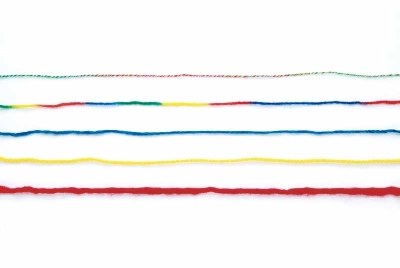
From tiptop to lesser: fingering, or baby, weight yarn; sport weight yarn;
DK weight yarn; worsted weight yarn; beefy, or chunky, weight yarn.
Within each of these categories are all sorts of yarn made from many different fibers. The fiber most often associated with knitting is wool. Wool is a beautiful, durable yarn that is a pleasure to piece of work with and holds its shape well. Cheque the fabric care symbols on the label carefully -- many wools aren't automobile washable. Before y'all cull wool, make sure yous're willing to intendance for it properly.
Cotton fiber yarns are very popular because they brand a cool and comfortable production. Cotton is usually labeled equally hand-wash just. Blends are any imaginable combination of fibers, including natural and synthetic. While nigh knitters prefer natural fibers, synthetics take their advantages. They are often inexpensive, readily bachelor, offer a wide color choice, and are piece of cake to intendance for.
Choose a yarn that'southward right for your pattern and based on your personal sense of taste. A practiced tip is to buy one brawl or skein (called the brawl from here on) of the yarn y'all desire to utilise before starting the project. Knit up a large swatch in the stitch blueprint, and wash or dry out-clean it in the same manner you'll use for your finished projection. You'll learn several things from this experiment: your gauge, if you similar working with the yarn, if the yarn shrinks or stretches after cleaning, and, most important, if the dye runs.
The next question is "How much yarn practise I buy?" That information is found in the design materials listing and on the yarn label. If you buy the brand the pattern calls for, simply cheque to see how many assurance are needed for the size y'all're making.
When substituting yarns, first determine if the new yarn brawl has the same number of yards or meters as the pattern yarn. Check the yarn characterization to see how many yards or meters the ball contains, and divide this number into the total yardage needed to decide how many assurance yous need. Circular this number upwardly to the nearest brawl to make sure yous'll take enough yarn.
Before purchasing, bank check the dye lot number on every brawl of yarn you lot've selected. Yarn is dyed in huge lots, or batches. When distributed to retail stores, dye lots are often mixed together. You lot may not be able to come across any divergence when comparison 2 dissimilar dye lots in the shop, but subsequently completing a project, you'll realize just how "off" two balls of "Off-White" can be. The probability of buying or finding matching dye lots months later on is unlikely. Bank check each dye lot number, and purchase all the yarn you'll need before you commencement your project. You'll be very glad you did.
Now that y'all accept your yarn and needles, you're ready to get started! Acquire all about casting on stitches in the next section.
It's likely yous'll eventually desire to add the following tools to your knitting bag.
- Bobbins:Bobbins are usually made of plastic and hold pocket-size amounts of yarn cut from the main ball. Knitters use bobbins for working intarsia knitting (patterns with a lot of color changes). The yarn is wrapped around the bobbin and and so pulled through one cease and joined to the knitting at the appropriate place.
- Cable needles: These short needles are used when crossing cable stitches. There are three bones types: a short, direct double-pointed needle; a double-pointed needle with a dip in the centre (to hold the stitches); and a U-shaped needle with one leg longer than the other. The mode you cull is a matter of preference.
Cable needles are available in dissimilar diameters. Cull 1 slightly smaller than your project needles. You only need i cable needle for a specific project because it is used only once for each cable twist.
- Crochet hooks: These hooks have many uses: picking up stitches, rethreading dropped stitches, endmost seams, or working crocheted edgings around knitted pieces. Some cast-on methods employ a crochet hook.
- Needle-size judge: This tool features a window that allows yous to mensurate stitch and row gauge at the aforementioned time. Some styles too have holes with which to measure basic needle sizes.
- Stitch holder: A sew together holder holds stitches off the needle until you need them. There are several types bachelor, including one that works like a rubber pin. Many knitters employ a length of shine cotton yarn and thread it through the stitches, tying the ends into an overhand knot to prevent the stitches from slipping off.
- Stitch markers: These petty tools help mark pattern sections, increases or decreases, or the beginning of a round in circular knitting. Markers are slipped onto your needle or are attached to the work through a stitch. When casting on many stitches, place a marker afterward every 20th sew, and quickly count across the row in sections of 20 stitches. To agree your place in a pattern, slip the marking from left to correct needle on every row. Markers come in contrasted sizes; employ the size closest to your needle size. Using i that is too big may stretch and misconstrue your stitches.
- Little extras: Other useful things to keep in your purse are knitter's coilless pins, safety pins, a small-scale notebook and pen or pencil, rustproof T-pins for blocking, mucilaginous notes for marker your identify in patterns or taking notes, an emery lath to smoothen a crude edge on a needle, and a travel pack of tissues.

Clockwise, from upper left: cablevision needles, run up markers,
stitch hooks, crochet hooks, needle-size estimate, bobbins .
Not what you're looking for? Effort these helpful articles:
- Knitting Instructions
- Free Baby Knitting Patterns
- Gratuitous Wearable Knitting Patterns
- Free Knitting Patterns for the Home
- Gratis Accessory Knitting Patterns
- Free and Easy Knitting Patterns
- Free Knitting Patterns
How to Cast On Stitches
The cast-on row is the foundation row of knitting. There are many ways to bandage on stitches. 1 method may exist faster or easier for you lot or may piece of work meliorate for certain techniques, such every bit buttonholes. Try each of the cast-on methods below, and starting time with the one that appeals to you most.
Note: The cast-on should be as rubberband as the body of your knitting. If needed, the cast-on may be worked using a needle two or 3 sizes larger than your gauge needle. Knit the stitches onto the smaller needle as you knit the first row.
Making a Slipknot
The first stitch on your needle for most cast-on methods is a slipknot.
Step 1: Hold the yarn in your left hand about viii inches from the end. With your correct manus, brand a circumvolve with the yarn (fig. 1a). If it'south helpful, hold the circle together between your index finger and thumb to foreclose it from slipping away.

Making a Slipknot: Figure 1a
Step 2: With the working yarn behind the circle, insert the knitting needle through the circle from front to back and take hold of the working yarn, pulling it through the circle and forming a loop (fig. 1b).

Making a Slipknot: Effigy 1b
Step three: With the new loop on the needle in your right mitt, gently pull both yarns (the tail and the working yarn fastened to the brawl) below the needle, so pull on the working yarn to tighten the new loop so that it fits snuggly around the needle (fig. 1c).

Making a Slipknot: Figure 1c
Cable Cast-on
This cast-on is especially good when you need a firm edge. Work loosely, without pulling the stitches too tight.
Step i: In your left hand, concur the needle with the slipknot and hold the working yarn in your right hand. Insert the right needle through the slipknot from front to dorsum (fig. 2a).

Cable Cast-on: Effigy 2a
Pace 2: Wrap the yarn around the right needle from back to forepart and pull upwards a loop, creating a new run up on the correct needle. Insert the left needle tip into the new stitch (fig. 2b), and skid it onto the left needle.

Cable Cast-on: Figure 2b
There are now ii stitches on the left needle (fig. 2c). Note: To forestall the cast-on edge from becoming likewise tight, insert the correct needle from front to dorsum between the 2 stitches on the left needle before tightening the yarn. Gently pull the working yarn to snug up the stitch.

Cable Cast-on: Effigy 2c
Pace 3: With the right needle in position between the 2 stitches on the left needle, wrap the yarn around the right needle as shown (fig. 2c), and pull through a new loop.
Step 4: Using the tip of the left needle, slip the new stitch from the right needle as earlier (fig. 2d), and skid the right needle out of the stitch.

Cable Cast-on: Figure second
Repeat steps three and 4 to bandage on additional stitches. End with pace iv to consummate the last cast-on stitch.
Long Tail (or Slingshot) Cast-on
The benefits of this bandage-on method are that it's quick to exercise and makes an rubberband border. Both working yarn and tail are used.
The tail length should exist roughly three times the width of your desired cast-on, or about 1 inch (2.5cm) per run up for worsted weight yarn, plus several inches extra for the yarn tail allowance to weave in later on. If you underestimate the length of yarn tail needed, pull out the piece of work, add more yarn to the length, and begin again. Or, begin the cast-on using two balls of the same yarn: One serves equally the "tail," and the other is the working yarn. Tie the ends together in an overhand knot, leaving about a 6-inch (15cm) tail, and then make the slipknot as usual and begin the cast-on. When the cast-on is completed, cut one of the yarns, leaving about vi inches (15cm), and brainstorm to work with the other. When the garment is finished, untie the overhand knot and weave in the loose ends.
Pace 1: Identify the slipknot onto the needle held in your right mitt, with the yarn tail in forepart (closest to you) and the working yarn (fastened to the ball) backside the needle. Pull the working yarn taut over the left forefinger, and wrap the yarn tail around your pollex from forepart to back. Secure both the working yarn and the tail between the remaining iii fingers of your left mitt and the palm. Identify the forefinger of your right hand on tiptop of the slipknot to hold information technology in place (fig. 3a).

Long Tail (or Slingshot) Cast-on: Figure 3a
Step 2: Insert the needle nether the yarn in front of your pollex, working from front to dorsum and pulling the yarn slightly upward (fig. 3b). Insert the needle over the yarn on your forefinger, moving from acme to bottom so the working yarn lies on summit of the needle to class the new stitch (fig. 3b).

Long Tail (or Slingshot) Cast-on: Effigy 3b
Step 3: Pull the needle toward you through the loop on your thumb as y'all remove your thumb from the loop (fig. 3c). At the same time, pull down on both pieces of yarn, tightening the stitch by pulling on the tail, keeping the sew together firm and even just still loose enough to slide easily.

Long Tail (Slingshot) Cast-on: Figure 3c
Echo steps to bandage on boosted stitches.
Uncomplicated Cast-on (Backward Loop Cast-on)
This cast-on is probably the easiest to learn, just it doesn't accept a groovy border similar other cast-ons. Use information technology when working a few cast-on stitches or on buttonholes. This cast-on tends to grow longer and become less manageable equally yous work the first row of knitting, and the bandage-on stitches tighten, making it hard to insert the needle.
Step 1: Place the slipknot on an empty needle with the yarn tail in back and the working yarn in front. Hold this needle with the slipknot in your correct manus.
Footstep 2: With working yarn in your left paw, wrap the working yarn over your thumb from front to back, and grasp it with your remaining fingers to tension (fig. 4a).

Simple Cast-on (Astern Loop Cast-on): Figure 4a
Step iii: Insert the needle under the yarn looped around your pollex, working from bottom to top (fig. 4b). Pull upwardly on the needle a petty as you slide the yarn off your thumb and onto the needle.

Unproblematic Bandage-on (Backward Loop Bandage-on) : Effigy 4b
Step iv: Gently pull on the working yarn to tighten the new sew together on the needle (fig. 4c).

Simple Cast-on (Backward Loop Bandage-on) : Effigy 4c
Repeat steps 2-4 to bandage on equally many stitches every bit desired. Terminate with step 4.
Knitted Bandage-on
This cast-on is easy to piece of work and is very similar to the cable cast-on. The difference betwixt the cable cast-on and the knitted cast-on occurs later on the get-go run up is made.
Stride 1: Identify the slipknot on an empty needle and hold in your left mitt, with the working yarn in your right hand. Insert the right needle through the slipknot from forepart to back (see fig. 2a to a higher place).
Footstep ii: Wrap the yarn around the correct needle from dorsum to forepart, and pull up a loop, creating a new sew together on the right needle. Insert the left needle tip into the new stitch (see fig. 2b above). Both needles remain in the new stitch.
Repeat pace 2 for each new stitch until all cast-on stitches are made. Withdraw the right needle after the last stitch is made. Although both needles remain in the new loop at all times, the stitches collect on the left needle only.
Nosotros'll swoop into learning one of the two bones knitting stitches -- the knit run up -- on the side by side folio.
Before you lot venture any further, look at the vi illustrations below. They will assist you empathise many things about knitting, so study them well and plan to return to this page often. When a bandage-on or sew design specifies working into the front loop or back loop, just friction match the instruction to the illustration to see exactly which part of the sew is beingness described.

Purling into back loop
Not what you're looking for? Endeavour these helpful articles:
- Knitting Instructions
- Free Baby Knitting Patterns
- Gratuitous Habiliment Knitting Patterns
- Complimentary Knitting Patterns for the Dwelling
- Free Accessory Knitting Patterns
- Free and Easy Knitting Patterns
- Gratis Knitting Patterns
Learning the Knit Stitch
Knitting has 2 basic stitches: the knit sew together and the purl run up. After mastering these stitches, y'all'll be able to create many sew together patterns.
Holding the Yarn
Experiment with the way you lot hold the yarn. Weave the yarn through your fingers as shown beneath, or effort other ways until you find a method that works for you and feels comfortable. The ability to tension the yarn as it flows through your fingers while knitting allows you to maintain your guess and work neat, fifty-fifty stitches. It'south also less tiring on the hands.

Property the yarn, using the American-English method
Knit Stitch (thousand)
Knitting is enjoyed and practiced all over the world, but not everyone knits in the aforementioned style. There is no correct or incorrect way of knitting. This commodity presents two of the more mutual knitting methods used in
English method, with the yarn held in the correct hand, and the Continental method, with the yarn held in the left hand.
The knit stitch is the most common and versatile stitch of all. It is smooth on ane side and bumpy on the other. The smoothen side is generally used as the right side of the piece of work -- the side that faces out. The working yarn is always held behind the needle when making the knit sew together. In other words, the knit material and the needle volition e'er be between you and the working yarn. When working flat, back and forth knitting, knitting every row creates garter stitch.
Knit Stitch, American-English Method
Stride 1: Concord the needle with the bandage-on stitches in your left hand. The working yarn is already attached to the stitch closest to the needle tip. Hold the empty needle in your right hand; take agree of the working yarn with your right hand, and hold information technology behind the right needle. Insert the empty needle from forepart to back through the first stitch on the left needle (fig. 5a). The right needle is underneath the left needle.

Knit Stitch, American-English language Method: Figure 5a
Step 2: Bring your right hand and forefinger toward the tip of the right needle (the yarn is underneath the right needle). Wrap the yarn around the right needle from back to front end (fig. 5b). Be careful non to wrap it around the left needle, too.

Knit Stitch, American-English Method: Figure 5b
Step three: Keeping the yarn firmly tensioned in your right mitt, bring the right needle toward yous, pulling a new loop through the one-time stitch (fig. 5c).

Knit Stitch, American-English Method: Figure 5c
Step 4: With the new stitch on the right needle, slip the quondam run up off the left needle (fig. 5d). Unlike the cast-on, the new knit stitches are held on the correct needle.

Knit Stitch, American-English Method: Figure 5d
You have but knit your first run up, American-English way. Repeat until all the cast-on stitches take been knit and are on the needle held in the right hand. Spring ahead to Knitting the Next Row, or cast on some other twenty stitches and try the knit stitch, Continental fashion.
Knit Stitch, Continental Method
As in the American-English method, the yarn is always held behind the piece of work when making the knit stitch.

Belongings the yarn, using the Continental method
Step one: Hold the working yarn and the needle with the cast-on stitches in your left mitt and the empty needle in your correct hand. Insert the empty needle into the offset stitch on the left needle, from front to back (fig. 6a). The right needle is under the left needle.

Knit Stitch, Continental Method: Figure 6a
Stride 2: Holding the yarn in your left hand, over the left forefinger and behind both needles, bring the yarn over the correct needle from left to right as shown (fig. 6b). Exist careful non to wrap it effectually the left needle.

Knit Sew, Continental Method: Figure 6b
Footstep three: Keeping the yarn firmly in your hand, pull the right needle and the yarn loop toward you, through the cast-on run up (fig. 6c).

Knit Stitch, Continental Method: Figure 6c
Stride four: With the new stitch on the right needle, slip the old stitch off the left needle (fig. 6d). Dissimilar the bandage-on stitches, the new knit stitches are held on the correct needle.

Knit Stitch, Continental Method: Effigy 6d
You lot have just knit your beginning stitch, Continental style. Repeat until all the cast-on stitches have been knit.
Knitting the Next Row, Either Style
The second and all subsequent knit rows are worked the same equally the first: Knit each stitch on the needle in the left mitt.
Step 1: When you take knit all the stitches from the left needle, turn the piece of work, switching the needle with all the stitches on it from your right hand to your left.
Step 2: The working yarn is attached to the sew together closest to the needle tip. Insert the right needle into the first stitch and repeat the knitting steps beyond the start row, working into each of the stitches of the previous row instead of into the cast-on stitches.
Notation: When outset each new row, brand certain the working yarn is beneath the needle holding the stitches and is non wrapped over the needle. If the working yarn is pulled upwards, the first sew will announced as two stitches, with both stitch loops actualization in forepart of the needle. If y'all knit both loops as single stitches, you'll increase the number of stitches on your needle. Recall, the forepart loop of each stitch should be in front of the needle and the back loop backside the needle (encounter Knit Loops and Purl Loops).
Every bit soon as y'all feel comfortable making the knit stitch, you can try the easier projects in our Free Knitting Patterns drove. To terminate these projects, you'll also need to practice binding off. For almost projects, you'll as well need to know the purl sew together, which you tin can acquire about on the next page.
Not what you're looking for? Try these helpful articles:
- Knitting Instructions
- Free Infant Knitting Patterns
- Free Clothing Knitting Patterns
- Free Knitting Patterns for the Domicile
- Free Accessory Knitting Patterns
- Free and Easy Knitting Patterns
- Costless Knitting Patterns
Learning the Purl Stitch
The purl stitch (p) is the contrary of the knit stitch. The yarn is always held in front of the work when making the purl sew together. As yous work this stitch, the bumpy side faces you and the side behind the needle is now the smoothen side.
When working apartment, back and along knitting, purling every row creates garter stitch, just the aforementioned as knitting every row. Alternating rows of knit and purl makes stockinette stitch, in which the knit side is the right side and the purl side is the wrong side. The purl side of stockinette stitch is called reverse stockinette stitch, which uses the purl side as the right side and the knit side as the incorrect side.
Purl Stitch, American-English language Method
Step one: Concur the working yarn and the empty needle in your right hand and the needle with the cast-on stitches in your left mitt. With the working yarn held in forepart of your work, insert the empty needle from right to left through the front loop of the first stitch (fig. 7a). The correct needle is in front end of the left needle.

Purl Sew together, American-English Method: Figure 7a
Footstep 2: Bring the yarn in your right hand toward the tip of the correct needle. Carry the yarn between the needles, and wrap it around the right needle from front to back, ending in front (fig. 7b). Be careful not to wrap it around the left needle.

Purl Stitch, American-English Method: Figure 7b
Step 3: Keeping the working yarn firmly in your correct manus, use the right needle to pull up a loop, moving backward and away from you through the stitch on the left needle (fig. 7c). With the new stitch on the right needle, slip the old stitch off the left needle.

Purl Run up, American-English Method: Effigy 7c
Repeat for each new stitch.
Purl Stitch, Continental Method
Stride 1: Concord the working yarn and the cast-on stitches in your left paw and the empty needle in your right hand. With the yarn held in forepart of your work, insert the empty needle from correct to left through the front loop of the showtime sew on the left needle (fig. 8a). The correct needle is in forepart of the left needle.

Purl Stitch, Continental Method: Figure 8a
Pace two: Wrap the yarn effectually the right needle from front to back, ending in the front (fig. 8b).

Purl Sew, Continental Method: Effigy 8b
Stride 3: Keeping the yarn firmly in your left mitt, employ the correct needle to pull a loop through the old stitch on the left needle, moving backward and away from yous (fig. 8c). With the new sew on the right needle, sideslip the quondam sew off the left needle.

Purl Stitch, Continental Method: Figure 8c
Repeat for each new sew together.
Purling the Next Row
The second and subsequent purl rows are worked the aforementioned every bit the first. Purl each stitch on the needle in the left hand.
Step one: When you lot have purled all the stitches from the left needle, plow the work, switching the needle with all the stitches from correct hand to left.
Step 2: The working yarn is fastened to the stitch closest to the needle tip and held in front of the work. Insert the correct needle into the first stitch with the yarn held in front of the stitches, and repeat the steps of the outset row, working into each of the stitches in the previous row instead of the bandage-on stitches.
Now that you've mastered knitting and purling, information technology's time to larn how to bind off stitches. Find tips on the side by side page.
Not what you're looking for? Try these helpful articles:
- Knitting Instructions
- Costless Baby Knitting Patterns
- Costless Vesture Knitting Patterns
- Gratuitous Knitting Patterns for the Home
- Gratuitous Accessory Knitting Patterns
- Free and Easy Knitting Patterns
- Free Knitting Patterns
How to Bind Off Stitches
The binding off (BO) technique finishes the final row and secures the stitches and then the needles tin can exist removed. You will often see the phrase "bind off in pattern." This ways work the final row of stitches as instructed, and bind off as you work. It sounds catchy, but it's not. The illustrations here show a knit row for the bind-off, simply yous'll want to practice the technique on both knit and purl rows.
Step 1: Hold the needle with stitches in your left hand and the empty needle in your right hand. Hold the yarn in position for the knit stitch, behind your work.
Step 2: Knit the starting time 2 stitches.
Footstep 3: Insert the left needle from left to right into the forepart loop of the first stitch on the right needle (fig. 9a). Note: This is the stitch farther from the right needle tip.

Bounden Off: Figure 9a
Step four: Utilize the left needle to pull this sew over the second stitch and drop it off the right needle. 1 sew together bound off; the second stitch remains on the right needle (fig. 9b).
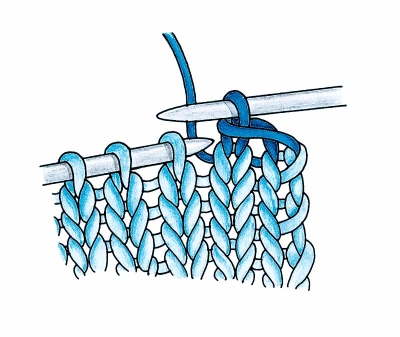
Bounden Off: Figure 9b
Pace five: Knit the next stitch.
Stride 6: Repeat steps 3-v until yous have bound off all stitches from the left needle and one run up remains on the correct needle. Cut the yarn nearly 4 inches from the stitch, and pull the yarn tail through the last sew together (fig. 9c). Remove the needle and pull the yarn tail to tighten.
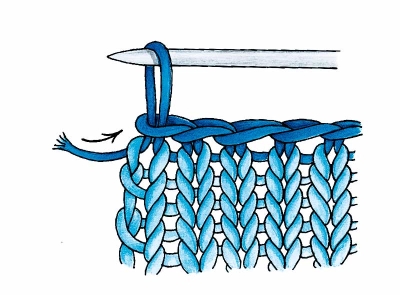
Binding Off: Effigy 9c
Many new knitters bind off too tightly. The spring-off border should be as elastic equally the rest of the knitting. If necessary, utilize a larger needle size to work the stitches in your demark-off row.
In the next section, yous'll find information on some of the nearly common knitting stitch patterns.
Not what you're looking for? Endeavor these helpful manufactures:
- Knitting Instructions
- Free Baby Knitting Patterns
- Free Clothing Knitting Patterns
- Costless Knitting Patterns for the Home
- Free Accessory Knitting Patterns
- Free and Piece of cake Knitting Patterns
- Gratis Knitting Patterns
Knitting Sew Patterns
At that place are many ways to combine stitches to create different patterns, simply the basis of every design is the knit stitch and the purl stitch.
Garter Sew (g st)
Knit every row in flat knitting, and you have garter stitch (fig. 10). It'southward a great stitch pattern for new knitters because it uses only ane unproblematic stitch. Because garter sew lays flat without curling, it's often used at the beginning and ends of rows to create flat, non-curling edges. Note: If you lot knit in the circular, on circular or double-pointed needles, you lot'll create stockinette stitch instead of garter sew.
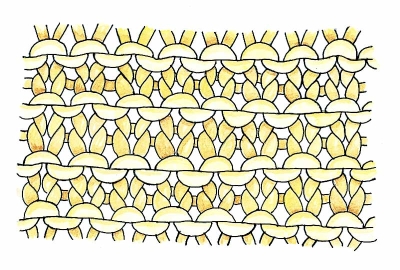
Garter Stitch: Effigy 10
Stockinette Sew (St st)
This is the nigh normally used run up pattern. But knit ane row, purl the next, and repeat to produce this pattern. Stockinette stitch will roll at the edges when not stabilized with other, not-crimper, sew together patterns, such every bit garter sew. Because of that, border stitch patterns are usually added to the lower and upper edges, and the side edges are sewn into the seam. To obtain an accurate measurement, y'all tin can block information technology to go along it flat temporarily.
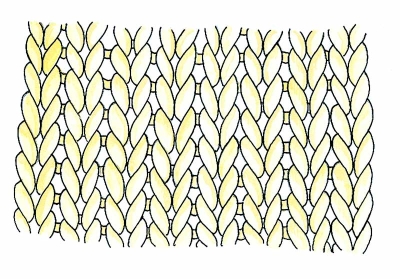
Stockinette Stitch (Knit Side): Figure 11a
The knit side (the smooth side) is called stockinette stitch (fig. 11a), and the purl side (or bumpy side) is chosen reverse stockinette sew (fig. 11b). Contrary stockinette stitch is often used as a background for cable patterns.
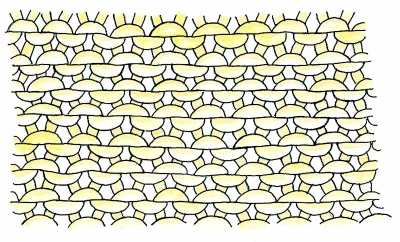
Opposite Stockinette Stitch (Purl Side): Figure 11b
Ribbing (rib)
You'll recognize ribbing as the run up found at the cuffs and hems of sweaters. It is a very elastic pattern and knits up narrower than stockinette sew on the same size needles. There are many ways of making ribbing, merely the nearly common are the single rib (fig. 12a) and the double rib (fig. 12b).
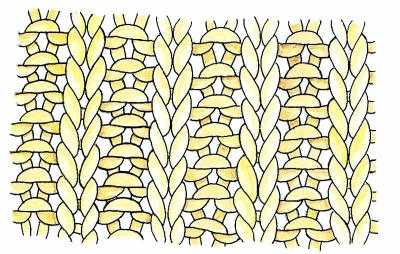
Single Rib: Figure 12a
The unmarried rib is made by alternate one knit stitch with i purl sew together (abbreviated as k1,p1). The double rib is more than rubberband than the unmarried rib and is made by alternate two knit stitches with two purl stitches (abbreviated k2,p2).
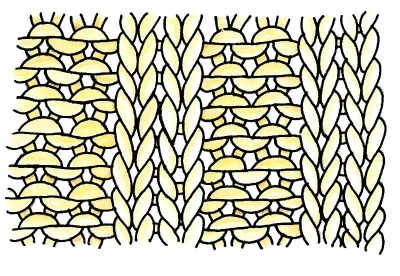
Double Rib: Figure 12b
The most important thing to recall when making ribbing is that the yarn must be brought between the needles to the back of the work for the knit stitches and brought betwixt the needles to the front end of the work for the purl stitches. Sometimes new knitters stop a row and discover extra stitches, or they may notice a hole in their ribbing several rows later. Knitting with the yarn in front end or purling with the yarn in dorsum is mostly the crusade. If you create a petty mix-up with your stitches, remember that you can easily fix knitting mistakes.
Ribbing is very like shooting fish in a barrel once you accept learned to recognize knit and purl stitches. Instead of counting stitches, you simply knit the knits and purl the purls.
New knitters may accept trouble agreement the instructions for knitting patterns at first. The tips on the adjacent page will help.
Not what you're looking for? Try these helpful articles:
- Knitting Instructions
- Complimentary Baby Knitting Patterns
- Gratuitous Vesture Knitting Patterns
- Gratis Knitting Patterns for the Home
- Costless Accessory Knitting Patterns
- Costless and Easy Knitting Patterns
- Free Knitting Patterns
Understanding Knitting Instructions
Like nigh crafts, knitting has its own linguistic communication. Knitting patterns utilize abbreviations, special terms, and punctuation. Knitting language may seem foreign and a petty intimidating at first, but you will quickly master it and be reading patterns like a pro.
At the first of a knitting blueprint, yous'll usually find a listing of techniques used in that project. Review the techniques listed, and when you run into ane you don't know, do the technique earlier starting the blueprint.
Render to the pattern you plan to make, and read any special notes or instructions. Locate the size you want to brand, and circle it throughout the blueprint. Or make a copy of the pattern, and highlight the right size numbers. In most patterns, the size numbers list the smallest size first, with the other sizes listed within brackets, beginning with the next size up, and then on. When one number or set up of instructions is given, it applies to all sizes.
When a Finished Size is listed, the numbers given refer to the garment size upon completion (provided you maintain the correct guess). These measurements include garment ease. Some patterns include both the body size and a finished size. For example:
Bust size: 36" [38", xl"]
Finished size: forty" [42", 44"]
Pay attention to punctuation. One sentence usually represents one row; commas and semicolons may mean that something's going to change with the adjacent run up or row. Instructions within asterisks, brackets, or parentheses are normally repeated, so wait for the directions that explain what to practise.
Schematics
These are line drawings of the basic garment pieces, to which measurements are added. Usually schematics show the bones measurements before neck ribbing, collars, or other embellishments are added. Check the schematic to determine which size volition best fit you lot in width and length.
In the concluding section, nosotros'll list some of the most common knitting abbreviations and their meanings.
Non what you're looking for? Try these helpful articles:
- Knitting Instructions
- Free Baby Knitting Patterns
- Gratuitous Article of clothing Knitting Patterns
- Free Knitting Patterns for the Home
- Free Accessory Knitting Patterns
- Free and Like shooting fish in a barrel Knitting Patterns
- Costless Knitting Patterns
Knitting Abbreviations
Use this central equally a reference for new and unfamiliar abbreviations found in knitting patterns.
| [ ] | Work instructions within brackets as many times as directed |
| ( ) | Work instructions within parentheses in the place directed |
| * | Repeat instructions following the asterisk as directed |
| * to ** | Echo instructions between the * and ** equally directed |
| alt | alternating |
| approx | approximate |
| beg | showtime/begin |
| bet | betwixt |
| BO | demark off |
| CO | bandage on |
| cont | keep |
| december | decrease/decreases/decreasing |
| dpn | double-pointed needles |
| foll | follow/follows/following |
| k st | garter stitch |
| inc | increase/increases/increasing |
| k or K | knit |
| k1,p1 | knit 1, purl 1 |
| k2tog | knit 2 together |
| kwise | knitwise |
| LH | left-hand |
| m1 | brand ane sew |
| m1 p-st | brand i purl stitch |
| p or P | purl |
| p2tog | purl 2 stitches together |
| pm | place marker |
| prev | previous |
| psso | laissez passer slipped run up over |
| pwise | purlwise |
| rem | remain/remaining |
| rep | echo(s) |
| rev St st | opposite stockinette stitch |
| RH | right-mitt |
| rnd(southward) | round(s) |
| RS | right side |
| sk | skip |
| skp | sideslip, knit, laissez passer slipped stitch over-1 stitch decreased |
| sk2p | slip 1, knit 2 together, laissez passer slipped sew over the knit 2 together -- two stitches decreased |
| sl | slip |
| sl1k | slip 1 knitwise |
| sl1p | slip 1 purlwise |
| sl st | sideslip stitch |
| ss k | slip, sideslip, knit these two stitches together -- a decrease |
| sssk | slip, skid, slip, knit these three stitches together -- a ii-stitch decrease |
| st(southward) | sew(es) |
| St st | stockinette run up |
| tbl | through dorsum loop |
| tog | together |
| WS | wrong side |
| wyib | with yarn in back |
| wyif | with yarn in front |
| yfwd | yarn forward |
| yo | yarn over |
| yon | yarn over needle |
Yous are now a knitter! Practice the bones stitches you learned until you feel comfortable with them, and recollect to refer back to the instructions if you get confused. Before you know it, yous'll be knitting without needing to call back most what your easily are doing.
Non what you're looking for? Try these helpful articles:
- Knitting Instructions
- Free Baby Knitting Patterns
- Free Clothing Knitting Patterns
- Free Knitting Patterns for the Home
- Costless Accompaniment Knitting Patterns
- Costless and Easy Knitting Patterns
- Free Knitting Patterns
Source: https://lifestyle.howstuffworks.com/crafts/knitting/how-to-knit.htm

0 Response to "How To Repair Snags In Knits"
Post a Comment